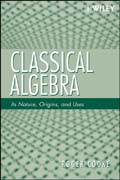
INDICE: Preface Part 1. Numbers and Equations. Lesson 1. What Algebra Is. 1. Numbers in disguise. 1.1. Classical and modern algebra. 2. Arithmetic and algebra. 3. The environment of algebra: Number systems. 4. Important concepts and principles in this lesson. 5. Problems and questions. 6. Further reading. Lesson 2. Equations and Their Solutions. 1. Polynomial equations, coefficients, and roots. 1.1. Geometric interpretations. 2. The classification of equations.2.1. Diophantine equations. 3. Numerical and formulaic approaches to equations. 3.1. The numerical approach. 3.2. The formulaic approach. 4. Important concepts and principles in this lesson. 5. Problems and questions. 6. Further reading. Lesson 3. Where Algebra Comes From. 1. An Egyptian problem. 2. A Mesopotamian problem. 3. A Chinese problem. 4. An Arabic problem. 5. A Japanese problem. 6. Problems and questions. 7. Further reading. Lesson 4. Why Algebra Is Important. 1. Example: An ideal pendulum. 2. Problems and questions. 3. Further reading. Lesson 5. Numerical Solution of Equations. 1. A simple but crude method. 2. Ancient Chinese methods of calculating. 2.1. A linear problem in three unknowns. 3. Systems of linear equations. 4. Polynomial equations. 4.1. Noninteger solutions. 5. The cubic equation. 6. Problems and questions. 7. Further reading. Part 2. The Formulaic Approach to Equations. Lesson 6. Combinatoric Solutions I: Quadratic Equations. 1. Why not set up tables of solutions?. 2. The quadratic formula. 3. Problems and questions. 4. Further reading. Lesson 7. Combinatoric Solutions II: Cubic Equations. 1. Reduction from four parameters toone. 2. Graphical solutions of cubic equations. 3. Efforts to find a cubic formula. 3.1. Cube roots of complex numbers. 4. Alternative forms of the cubic formula. 5. The irreducible case. 5.1. Imaginary numbers. 6. Problems and questions. 7. Further reading. Part 3. Resolvents. Lesson 8. From Combinatorics toResolvents. 1. Solution of the irreducible case using complex numbers. 2. Thequartic equation. 3. Viµete's solution of the irreducible case of the cubic. 3.1. Comparison of the Viète and Cardano solutions. 4. The Tschirnhaus solution of the cubic equation. 5. Lagrange's reflections on the cubic equation. 5.1.The cubic formula in terms of the roots. 5.2. A test case: The quartic. 6. Problems and questions. 7. Further reading. Lesson 9. The Search for Resolvents.1. Coefficients and roots. 2. A unified approach to equations of all degrees.2.1. A resolvent for the cubic equation. 3. A resolvent for the general quartic equation. 4. The state of polynomial algebra in 1770. 4.1. Seeking a resolvent for the quintic. 5. Permutations enter algebra. 6. Permutations of the variables in a function. 6.1. Two-valued functions. 7. Problems and questions. 8.Further reading. Part 4. Abstract Algebra. Lesson 10. Existence and Constructibility of Roots. 1. Proof that the complex numbers are algebraically closed. 2. Solution by radicals: General considerations. 2.1. The quadratic formula. 2.2. The cubic formula. 2.3. Algebraic functions and algebraic formulas. 3. Abel's proof. 3.1. Taking the formula apart. 3.2. The last step in the proof. 3.3. The verdict on Abel's proof. 4. Problems and questions. 5. Further reading. Lesson 11. The Breakthrough: Galois Theory. 1. An example of a solving an equation by radicals. 2. Field automorphisms and permutations of roots. 2.1. Subgroups and cosets. 2.2. Normal subgroups and quotient groups. 2.3. Further analysis of the cubic equation. 2.4. Why the cubic formula must have the form it does. 2.5. Why the roots of unity are important. 2.6. The birth of Galois theory. 3. A sketch of Galois theory. 4. Solution by radicals. 4.1. Abel's theorem. 5. Some simple examples for practice. 6. The story of polynomial algebra: a recap. 7. Problems and questions. 8. Further reading. Epilogue: Modern Algebra. 1. Groups. 2. Rings. 2.1. Associative rings. 2.2. Lie rings. 2.3. Special classes of rings. 3. Division rings and fields. 4. Vector spaces and related structures. 4.1. Modules. 4.2. Algebras. 5. Conclusion. Appendix: Some Facts about Polynomials. Answers to the Problems and Questions. Subject Index. Name Index.
- ISBN: 978-0-470-25952-8
- Editorial: John Wiley & Sons
- Encuadernacion: Rústica
- Páginas: 206
- Fecha Publicación: 16/04/2008
- Nº Volúmenes: 1
- Idioma: Inglés
- Inicio /
- MATEMÁTICAS /
- ÁLGEBRA
